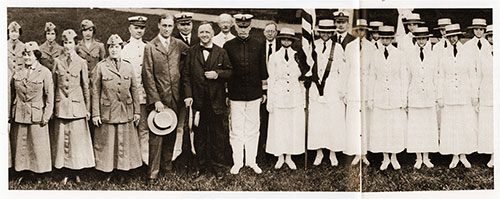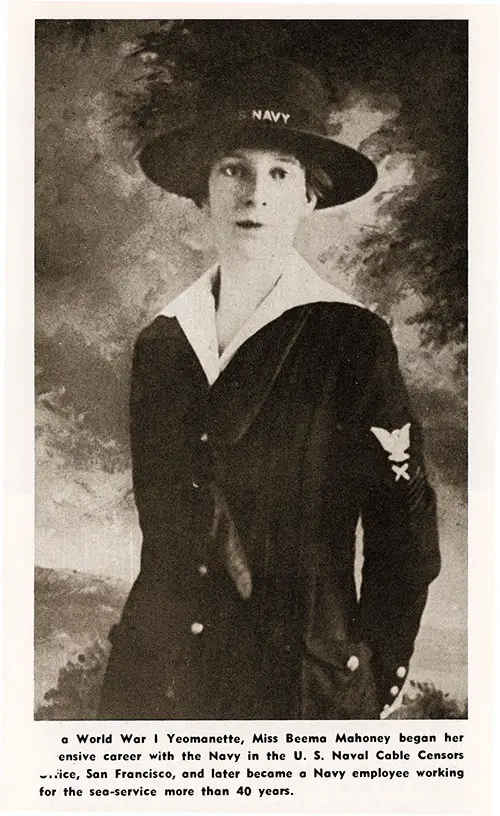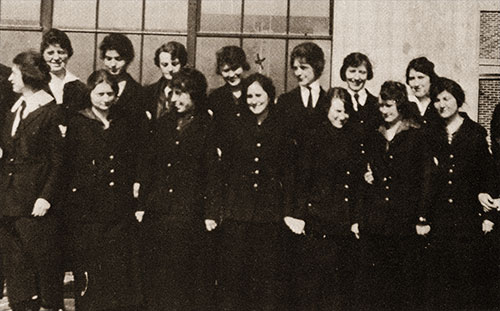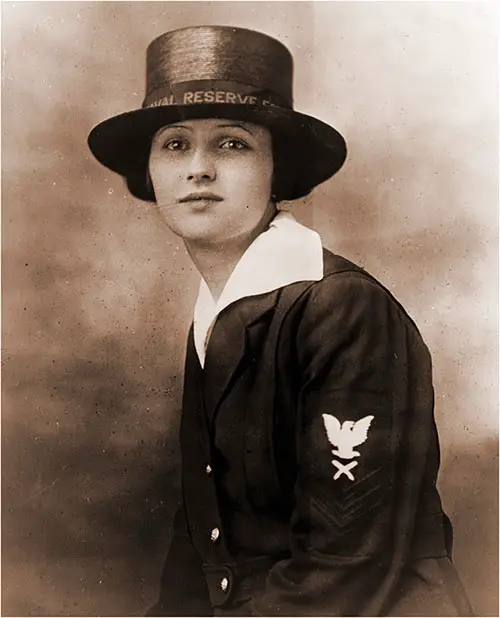Navy Women of World War One - 1972

Yeomen (F) and U. S. Marine Corps Women Reserves (Marinettes) at their final review by Secretary of the Navy Josephus Daniels (center) and then-Assistant Secretary of the Navy Franklin D. Roosevelt (left, holding hat). All Hands: The Bureau of Naval Personnel Career Publication, July 1972. GGA Image ID # 18d32b4b6a
The History of Women in The Navy does not begin with the World War II organization of the Waves —Women Accepted for Volunteer Emergency Service —which came into being on 30 July 1942. It dates back more than a third of a century earlier, to the year 1908 when the Navy Nurse Corps was established.
Women also performed an important role in the naval service during the first World War, when more than 11,000 came on active duty; Josephus Daniels, Secretary of the Navy in WWI, himself tells the story of how this came about.
There was a particular need for yeomen and personnel in related jobs to handle the burgeoning demand from headquarters and naval shore stations as the Nation readied itself for WWI.

A World War I Yeomanette, Miss Beema Mahoney Began Her Extensive Career With the Navy in the U. S. Naval Cable Censors Service, San Francisco, and Later Became a Navy Employee Working for the Sea-Service More Than 40 Years. All Hands: The Bureau of Naval Personnel Career Publication, July 1972. GGA Image ID # 18d330edc9
"Is there any law that says a yeoman must be a man?" SecNav Daniels asked his legal advisors.
"The answer was that there was not, but that only men had heretofore been enlisted. The law did not say ‘male.’"
"Then enroll women in the Naval Reserve as yeomen," Navy Secretary Daniels said. In such jobs, he added, they would offer the best "assistance that the country can provide."
The Establishment of Yeoman (f), better known as the Yeomanette, was accomplished under the provisions of an Act of 29 Aug 1916, which set up the Naval Reserve Force.
The Navy Department sent the following letter to all commandants of naval districts, on the subject of the Enrollment of Women in the Naval Coast Defense Reserve.
"After a careful reading of . . . the Act . . . nothing can be found which would prohibit the enrollment in the Naval Reserve Force and in the class mentioned of women. On the contrary, it is believed that their enrollment was contemplated."
Immediately after the U. S. entered World War I, women were taken in on a large scale "in order to release enlisted men for active service at sea."
As a result a total of 11,275 Yeomen (F) were in service at the time the armistice was signed and most of the immense volume of clerical work at the Navy Department, in addition to many highly important special duties, was being handled by them.
Along with the purely clerical and administrative duties performed by the Yeomen (F), others served as translators, draftsmen, fingerprint experts, camouflage designers, and recruiting agents.

Payroll Department of the Bureau of Navigation, December 1918. All Hands: The Bureau of Naval Personnel Career Publication, July 1972. GGA Image ID # 18d34b81a6
Five Yeomen (F), enlisted in the Bureau of Medicine and Surgery, served with Navy hospital units in France. One served in connection with the operations of the Office of Naval Intelligence in Puerto Rico.
Yeomen (F) were stationed in Guam, the Panama Canal Zone, and Hawaii, in addition to the United States and France.
About 300 “Marinettes,” as the feminine enlisted personnel of the Marine Corps were designated, were on duty during the war. Most of them were stationed at Marine Corps Headquarters at the Navy Department, although a number were assigned with Marine Corps recruiting units.
All Yeomen (F) were released from active duty by 31 July 1919, and to them Secretary Daniels sent the following message:
"It is with deep gratitude for the splendid service rendered by the Yeomen (F) during our national emergency that I convey to them the sincere appreciation of the Navy Department for their patriotic cooperation."
As enlistments had been made for four years, the Yeomen (F) were continued on the rolls of the Navy in inactive status and received the retainer pay of $12.00 a year until the expiration of enlistment, when they were discharged from the naval service.
A large number of women who had been on duty in the Navy Department and at Navy yards and stations, were given temporary appointments to similar positions under the Civil Service.

Joy Bright Hancock, Yeoman First Class, USNR, half-length portrait, facing front, body turned to left profile, wearing uniform, February 1918. Official U.S. Navy Photograph. Library of Congress, LC # 2002713059. GGA Image ID # 18d3545370
Incidentally, there were provisions for military preference for former Yeomen (F) in Civil Service positions and they were allowed an increase of five per cent on Civil Service ratings for permanent jobs. They were also included in all subsequent benefits affecting World War I veterans.
"Yeomanettes: Navy Women of World War One," in All Hands: The Bureau of Naval Personnel Career Publication, NAV-PERS-O, No. 666, July 1972, pp. 14-15.
